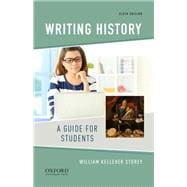An indispensable resource for thousands of history students over five editions, Writing History: A Guide for Students provides a wealth of tips and advice to help students research and write essays for history classes. Bringing together practical methods from both history and composition, it covers all aspects of writing about history, including finding and researching topics, interpreting source materials, drawing inferences from sources, and constructing arguments. It concludes with three chapters that discuss writing effective sentences, using precise wording, and revising.
Using numerous examples from the works of cultural, political, and social historians, Writing History serves as an ideal text for any history course that asks students to conduct research. The sixth edition offers better guidance on how to begin a research paper and expanded sections on oral history and visual and material sources








